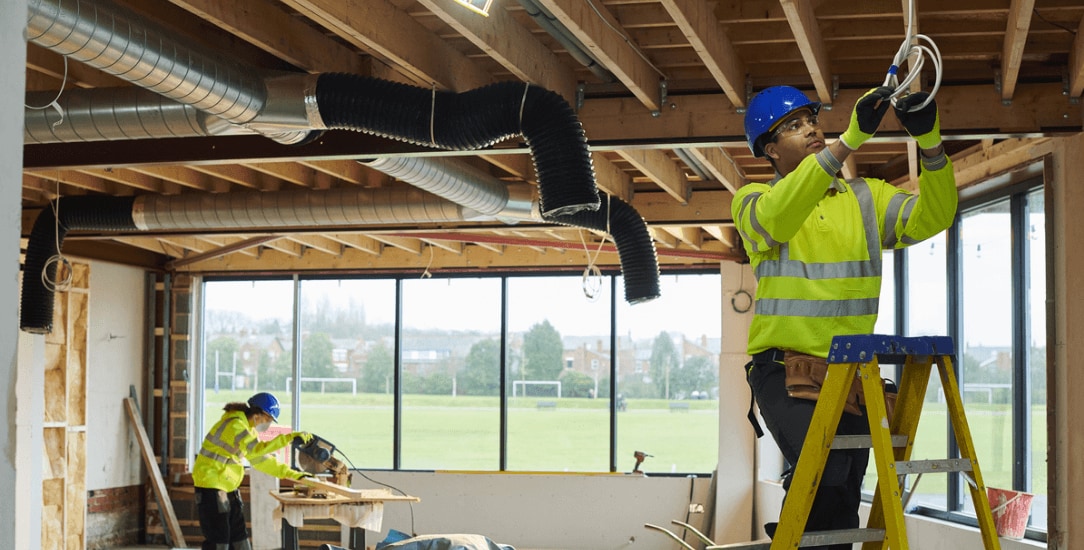The electrical engineering sector is always on the lookout for a layout solution to improve on-site safety and operational processes. Traditionally, there's been a stark distinction between where construction layout plans end and electrical work begins. But with site printing robotics, that's quickly changing.
In fact, robotics and automation are shifting the very landscape of AEC. They're simplifying and accelerating the layout process while improving communications between construction and engineering teams. When digital building designs must become a tangible reality, electrical is often one of the primary teams construction firms depend on to ensure site plans will come to fruition safely and efficiently.
Understanding the Electrical Engineering Industry
From an electrical engineering standpoint, an accurate site layout requires integrating numerous disparate systems into a cohesive and unified plan of action. Electrical engineers draw from various diagrammatic layouts, calculations and specifications tables, and modeling tools. In turn, the on-site electricians and layout technicians must ensure they convey exactly the right data at the proper time and to the right parties.
Accurately conveying electrical plans is absolutely essential to site safety throughout construction. By printing important wiring diagrams, power ratings, component placement,
and other key information straight onto a site, electricians and other construction teams no longer need to take their eyes off their physical, hands-on work to retain the most essential information.
Contrast this layout solution with the alternative: continually checking numerous separate design files and then ensuring accurate on-site implementation. By the time major electrical work begins, much of the preliminary structure is standing. The need to reconcile digital CAD files with manual on-site layouts can become enormously time-consuming and complex.
Challenges in Electrical Layout Design
The electrical engineering team knows project success depends on a fast and accurate layout solution. However, all manual site printing methods have traditionally required a tremendous amount of labor. In addition to added manual work, the electrical team must engage in continual error correction and communicate plans effectively to the other MEP and construction teams.
These extra efforts still don't eliminate the possibility of error, leaving crews operating in good faith. Given the breadth of electrical site design tools, real-time error correction is simply not an option. There may even be numerous parties involved in manually printing the electrical plans, leaving the door open to various misinterpretations.
Previously, the closest electrical engineers could get to automating the layout process was to continually cross-reference vast amounts of data and reconcile various 3D and 2D images using networked project management tools. But this doesn't automate the drawing process by any measure.
It can also be enormously complicated for construction management firms and general contractors. They must ensure each MEP service is accomplished in the proper sequence. Robotic site printing is the solution, especially considering projects often depend on a fast and accurate site print for each engineering and construction team. Sometimes, those tasks are even required on demand.
Introduction to Robotic Layout Solutions
A cloud-connected and automated site printing robot dramatically sharpens the accuracy and efficiency of building layouts. At an electrical site, the best layout solution must translate every key aspect of the project into a single on-site print with impeccable clarity and pinpoint accuracy. It's a technical endeavor best suited to machine automation, and it's now possible.
MEP trades typically use BIM models in their designs. A single design can include various formats, including 2D drawings, 3D models, or even .csv files with point coordinates and more. To streamline operations, HP SitePrint leverages HP's advanced conversion software to translate each model into a .dxf file. The SitePrint robot can then read and streamline the entire CAD preparation process before translating those instructions into 1:1 accurate site print.
HP's innovative SitePrint technology prints CAD files directly onto a construction site. This dramatically reduces the chance of error in both drawing and interpreting site layouts. Site printing is the culmination of several highly involved technical sciences:
- Advances in robotics, sensors, and positioning systems
- Cloud computing & data processing
- Digital project management tools
- Printing technology supporting a broad range of permanent and removable inks compatible with various surfaces
The SitePrint robot automatically accomplishes what would otherwise require extensive labor and provides no guarantee of accuracy or quality.
Where RTS Fits In
The brain of SitePrint is its Robotic Total Station (RTS), which itself receives commands from the cloud. This allows a single person to manage the project and ensure electrical designs go as planned, without conflicting with other elements of the site layout. Cloud connectivity also simplifies the most essential communication pathways:
- Office to on-site crews
- Between individual teams
- Companies to shareholders, investors, and stakeholders
All these parties depend on safe building operations, even under strict time constraints. By seeing the latest and most accurate building plans at a glance, everyone impacted by the electrical plans can rest assured their interests are being met—especially the need to avoid accidents and minimize delays.
Benefits of Robotic Layout Solutions
As strong adopters of RTS technology, MEP trades can be at the forefront of using RTS to print directly onto the site. SitePrint is the next step in their automation journey, which automates both positioning and printing processes. That means no more bending down to mark points on the floor with a marker and no more second-guessing your work.
Along with SitePrint's intrinsic time savings, it also improves coordination and efficiency amongst construction teams, giving everyone confidence that they can simply read it and build it.
Automated site print robots provide numerous additional benefits not otherwise possible with manual alternatives, including:
- Direct printing of CAD files, text, and symbols onto a variety of surfaces
- Accurate printing to within 3 mm
- The choice between lasting or permanent prints
- Compatibility with a wide range of porous and smooth surfaces
- Proven 10x increase in efficiency over manual alternatives
- Reduction in site layout labor requirements
- Adaptability to changing environmental conditions
- Integration with other BIM solutions and cloud-based project management tools
Integration Challenges and Solutions
Existing electrical engineering layout processes require extensive planning, making it essential to achieve accurate execution for minimal resources. At times, engineering firms have been compelled to outsource these functions, creating an unnecessary link in the liability and error-correction chain.
While having to conform complex schematics to real-world conditions won't change, the ability to fulfill these same operations with a robot ensures firms can be more certain in their chosen layout solution. In HP's development and refinement of the initial wave of SitePrint technology, electrical engineers have actually been some of the fastest adepts in learning how to manage the equipment and print their designs directly on site.
The critical point in the MEP process is installing systems after they're marked on the floor. Because SitePrint can also print large text labels next to each point or line, providing clear instructions and greater success during assembly without manually placing stickers or handwriting instructions as you go. It also reduces the likelihood of wrong hanger locations, meaning less unnecessary concrete drilling.
To integrate robotic site printing into your large-scale electrical projects, we and our partners can recommend four essential changes to your workflows:
- Always keep the latest plans updated with a 2D .dxf CAD drawing.
- Whenever that's not possible, include a note referencing further materials in the CAD drawing.
- Coordinate with other MEP teams and construction management about potential site layout overlaps or conflicts.
- Give stakeholders access to a view-only version of the site layouts directly via the cloud—the ultimate in real-time progress reporting!
Accurately Convey Electrical Plans With Lightning Speed
After active pilot testing in over 80 enterprise-level construction sites around the world, HP SitePrint is slated for full commercial release. We're also continually working with construction and RTS leaders to integrate our robotics software with the latest advances in electrical site design, just as we constantly optimize the printing technology to create a complete layout solution.
Electrical engineering firms, in particular, stand to benefit from direct site printing due to their need to distill countless dynamic design processes into one clear, ready-to-go site layout. Now, all MEP trades have a consistent machine-driven process for conveying essential design and safety information, improving their relationships in the AEC industry as a whole.
If your engineering firm is eager to take the next step in electrical site layout solution automation, contact us using the form in the upper right corner of the window.
Selected for you
5 ways HP SitePrint can help transform your building operations
Bringing the power of HP’s ink innovation to construction sites
Digital Transformation in construction: why general contractors must adapt
Contact us
Talk with an expert
Contact us to get pricing information and to take par in the HP SitePrint Early Access Program.
Stay informed
Sign up to stay informed on the evolution of HP SitePrint and an entire industry.
Footnotes
https://www.levelset.com/blog/2020-report-construction-wasted-time-slow-payment
https://www.wrike.com/blog/lack-visibility-is-visibly-hurting-team/
https://www.siteaware.com/post/the-challenge-and-root-causes-of-rework
https://www.gim-international.com/content/article/total-stations-the-surveyor-s-workhorse



